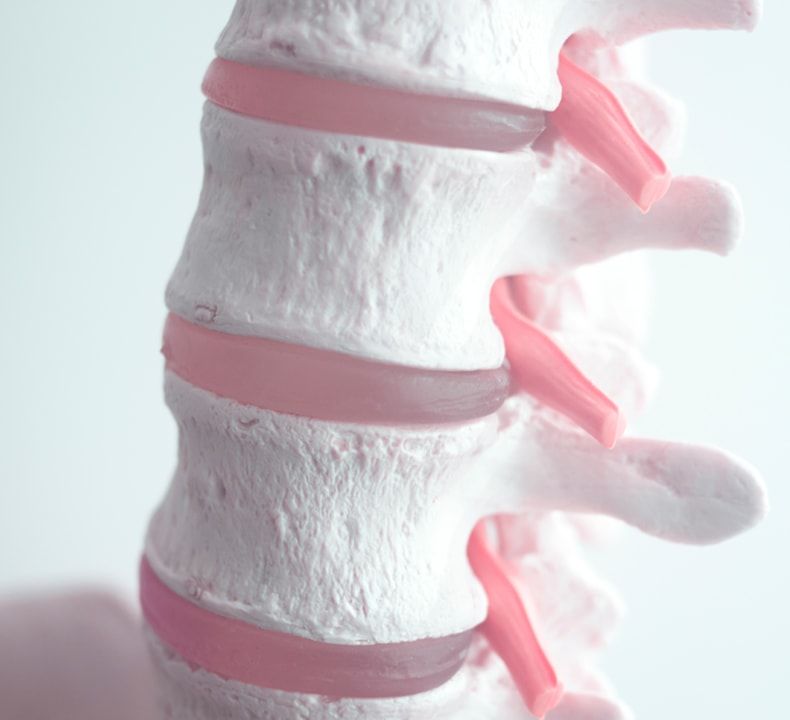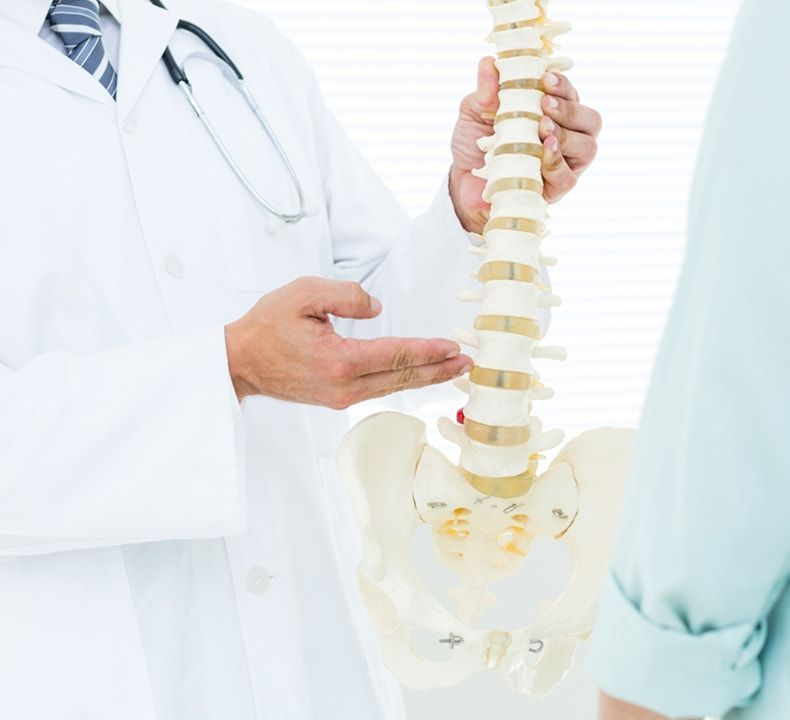ALIF
ANTERIOR LUMBAR INTERBODY FUSION
The lumbar spine is made up of five bones, called vertebrae. Between each vertebra are discs, which provide the cushion necessary for spinal rotation and bending. These are called intervertebral discs. Each disc is comprised of two parts, a tough and fibrous outer layer (annulus fibrosis), and a soft, gelatinous center (nucleus pulposus). These two parts work in conjunction to allow the spine to bend, twist, and also provide shock absorption.
What is causing my pain?
There are several primary causes of lumbar spine problems. The majority of the symptoms are caused by disc, bone, or ligaments pressing onto the nerve roots or spinal cord.
During the natural aging process, the discs between each vertebral body can lose their flexibility, height, and elasticity, which can cause a tear in the tough outer layer of the disc, causing the disk to herniate, bulge, or leak the gelatinous core. The bulges or leakages can end up compressing the roots and/or spinal cord, causing symptoms including, but not limited to, lower back and/or leg pain.
What are my treatment options?
Many symptoms can be treated without surgery with methods that involve medicine, rest, heat, and physical therapy. It is important that you speak to your physician about the best options for you.
If your symptoms do not improve with other non-operative methods, such as physical therapy, your physician may suggest spinal surgery. Surgery is reserved for those who do not gain relief from nonoperative forms of treatment and/or patients whose symptoms are increasing or worsening.
What is an eXtreme Lateral Interbody Fusion (XLIF®) procedure?
ALIF is a procedure used to treat problems such as disc degeneration, spine instability, and deformities in the curve of the spine. In this procedure, the surgeon works on the spine from the front (anterior) and removes a spinal disc in the lower (lumbar) spine. The surgeon inserts a bone graft into the space between the two vertebrae where the disc was removed (the interbody space). The goal of the procedure is to stimulate the vertebrae to grow together into one solid bone, a process known as fusion. Fusion creates a rigid and immovable column of bone in the problem section of the spine. This type of procedure attempts to reduce back pain and other symptoms.
Anterior approaches, such as in ALIF, allow access to the discs at the front of the spine and do not require muscle stripping as in posterior approaches. ALIF provides the surgeon with a clear and uncomplicated approach to the lumbar spine and patients tend to experience less incisional pain from this approach.
Is an Anterior Lumbar Interbody Fusion right for me?
Your physician might determine an Anterior Lumbar Interbody Fusion procedure is a good option for you if you require an interbody fusion, are skeletally mature, and have received at least six weeks of non-surgical treatment.
Conversely, your physician may determine that an Anterior Lumbar Interbody Fusion procedure is not a good option for you if you are not a good candidate for fusion surgery in general due to other medical conditions. These conditions can be, but are not limited to: signs of inflammation or infection near the operative site, patient sensitivity to implant materials, patients with inadequate bone quality, previous retroperitoneal surgery, previous aortic bypass or endovascular stent graft, and other indications
What can I expect...? Before surgery
Your physician will review your condition and explain all of your treatment options, including medications, physical therapy, and other surgeries, such as removal of the diseased disc, fusion, etc. On the day of your surgery, you will probably be admitted to the hospital early in the morning. You shouldn’t eat or drink anything after midnight the night before. Your physician will provide thorough preoperative instructions. Once you have been admitted to the hospital, you will be taken to a pre-op room and prepared for surgery. This may include instruction about the surgery, cleansing of your surgical site, as well as instruction about the postoperative period.
What happens during surgery?
After you are sedated, positioned on your back and draped, an x-ray is taken of your spine to identify the location of the operative disc space.
Step 1. Approach
Traditionally, a small incision is made through one side of the abdomen. The large blood vessels that lie in front of the spine are gently moved aside.
Step 2. Disc Removal
The diseased or damaged disc is removed to reduce pressure from the symptomatic cord or nerve root.
Step 3. Implant
An implant is inserted into the void left once the disc is removed. This implant acts as a scaffold for bone to grow through, which will eventually stabilize that segment of your spine once fusion (bone growth) occurs. This may include fixation as a standalone device.
Step 4. Fixation
A small plate and screws are then placed over the disc space to act as a stabilization device (internal brace) to help hold everything in place while fusion occurs.
What can I expect...? After surgery

After surgery, you will wake up in the recovery room, where your vital signs will be monitored and your immediate postoperative condition will be carefully observed. Most patients stay in the recovery room between one and three hours after surgery. Once the medical staff feels that you are doing well, you will be returned to your room in the hospital. It is normal for your incision to be sore immediately after surgery. The nursing staff will be checking to make sure that your vital signs are stable and that there is no problem with either the wound or nerve functions in your extremities.
Most ALIF patients are discharged from the hospital the day after surgery, but your physician will determine the best postoperative course for you, depending on your comfort and any other health problems you may have. Your physician will discuss with you any pain medications to take home, as well as a prescribed program of activities
Are there risk involved?
Keep in mind that all surgery presents risks and complications that are important to discuss with your physician prior to your surgery. Listening to your physician’s guidance both before and after surgery will help ensure the best possible outcome from your procedure.
Risks associated with the ALIF procedure include: blood vessel damage, problems with the interbody device or hardware, retrograde ejaculation (in males), deficit or damage to the spinal cord, nerve roots, or nerves, possibly resulting in paralysis or pain. Please contact your physician to discuss all potential risks.

Slide title
Write your caption hereButton
Slide title
Write your caption hereButton
Frequently asked questions
-
Can I shower after surgery?
Depending on your surgical incision, you may have showering restrictions. Ask your physician for appropriate instructions.
-
Will I have a scar?
This surgery involves a small incision on the anterior (front) of your abdomen. The size and location of the incision will depend on which spinal level(s), and how many, are symptomatic. Ask your physician for more information, as every patient is different.
-
When can I drive?
For a period of time after your surgery, you may be cautioned about activities such as driving. Your physician will tell you when you may drive again.
-
Can I travel?
The implants used in the ALIF procedure may activate metal detector. Because of increased airport security measures, please call your local airport authority before traveling to get information that might help you pass through security more quickly and easily. Ask your physician to provide a patient identification card.





